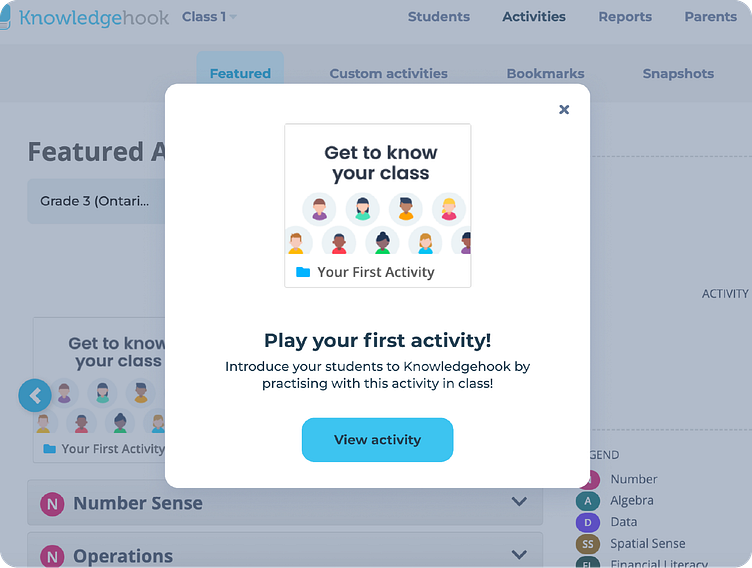Onboarding activity for math app
I designed a fun, no pressure classroom icebreaker activity for a math app to drive users towards Knowledgehook’s core value proposition as quickly as possible.
Continue reading below for the entire case study!
About Knowledgehook
To play Knowledgehook, teachers pick an activity—short visual quizzes made up of multiple choice and yes/no questions— and host learning sessions in class. Students are prompted to answer questions on their own devices, are scored by their responses, and finally, are ranked by their performance as a class.
The problem
First-time users hesitate to run their first math activity in class using Knowledgehook because they have not prepared the math material or lesson, with the added unfamiliarity of a new app and how it works.
By offering an icebreaker activity that consists of simple open-ended questions and doesn’t require math knowledge, we remove the math anxiety preventing first-time users from trying out the key features of the app.
Research
Our discovery work and solutioning focused on validating 4 questions.
What do teachers do on their first week teaching a new class?
This question will help us solve what CONTENT to provide our user. Interviewing several teachers revealed that before they even begin teaching any lessons, teachers like to focus on getting to know their students and building a good teacher-student relationship. A popular method is preparing classroom icebreaker activities. Some students (and even teachers) will be nervous. These activities can help to ease the tension.
Can users navigate to their first activity and run the experience smoothly on their own? This question will help us solve what visual design, copywriting, and position of this activity will help to optimize for the activity’s effectiveness. We gave the activity name a clear and concise title, “Get to know your students”. We needed to set the expectation of the activity right away and align it with exactly what teachers want to do when they start a new class. The visual design is kept simple and white based on user feedback that our bright and colourful activities intimidated new users because it appeared too ‘advance’. And lastly we positioned the activity to be the first activity on the top-left of the activity selection page. This is intuitive for a new user who is exploring their first activity.
Is it feasible to create open-ended questions in our app without recording responses as incorrect. We always collaborate closely with our developers to ensure the technical feasibility of any new product or design idea. Although Knowledgehook consists of a wide array of math questions, they are all designed as close-ended questions. The major difference between close-ended math questions and open-ended math questions is that close-ended ones have one answer (e.g., multiple choice, true/false, and numeral input questions) and open-ended ones have more than one solution, approach, and representation. Open-ended questions are difficult for the platform to analyze as correct or incorrect because of its open-ended nature. We worked with developers to make sure the captured responses from this activity would not affect our student reporting and assessment captured from other math activities. On the student-facing end, we made sure that anything that can suggest an ‘incorrect’ answer is hidden for this activity to nurture a safe and positive learning mindset for students.
Does the activity align with our values and curriculum learning expectations? We went a step further and designed our questions so that they met the government's curriculum requirement for social-emotional learning. In math, this focuses on a student’s mindset, perseverance, risk-taking, and attitude—which are foundational skills teachers like to apply early on, even before starting a new unit. Not only is this activity a great icebreaker for teachers, but principals and districts are happy as well that it covers this requirement. This was an extremely important detail when developing for a B2B business, not only are we creating value for the customer but also for stakeholders who provide the service to those customers.
Solution
We carefully designed the new Mathematical Mindset Survey (see below) considering the format, naming of the activity, how the questions are framed, and supporting illustrations. It has become a valuable part of the onboarding experience. Not only was it designed as an icebreaker activity with students, it functions as an icebreaker for our teacher users using the product for the first time, too!
Result
Knowledgehook successfully went live with the new activity at the beginning of the 2023-2024 school year with 20,000 uses in the first 2 months of release. 🎉

